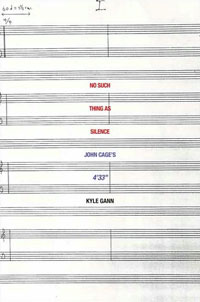Sounds of Silence

Avante-garde composer John Cage's composition 4’33” created at the midpoint of the twentieth century, was conceived of without a single musical note. In his monograph No Such Thing as Silence: John Cage’s 4’33”, composer and Bard music mentor Kyle Gann writes:
4’ 33”
Gann unpacks Cage’s craft and explicates in detail the context for his pioneering artistic gesture. And having performed 4’33”, he offers both an interior and exterior perspective of this iconic musical “composition.” He also reports that the piece cost Cage some friends and prompted his mother to ask, “Don’t you think that John has gone too far this time?”
Gann concludes:
4’33”4’33”4’33”4’33”
Incidentally, the Cage book is part of Yale University Press’s “Icons of America” series, which includes about a dozen titles on subjects ranging from Fred Astaire to the hamburger to the Empire State Building.
